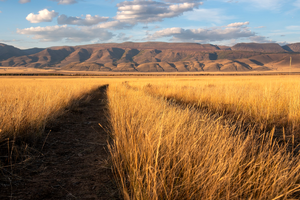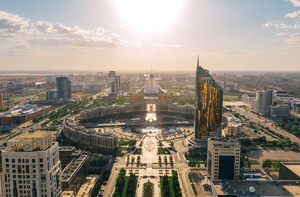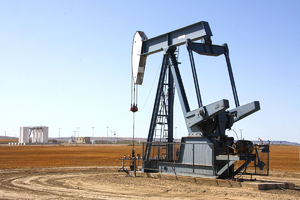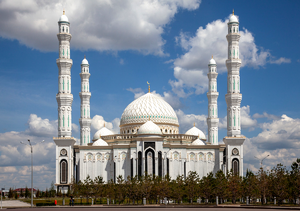Hordestan
Socialist Union of Hordestan Социалистік одақ Ордестан | |
|---|---|
| Anthem: The Internationale | |
 | |
| Capital | Karakent (Қаракент) |
| Official languages | Hordish (Turkic language) |
| Government | Federal one-party socialist republic |
• Chairwoman | Danica Woitanowa |
| People's Congress | |
| Union Congress | |
| Area | |
• | 1,025,600 km2 (396,000 sq mi) |
| Population | |
• Estimate | 56,000,000 |
• Density | 55/km2 (142.4/sq mi) |
| GDP (PPP) | estimate |
• Total | $914.62 billion |
• Per capita | $16,332 |
| Currency | Tengri (₮) |
| Driving side | right |
The Socialist Union of Hordestan, Социалистік одақ Ордестан, is a socialist state in South Central Ausiana. Hordestan is basically a landlocked country, connected to the Beleroskov Sea only by the narrow Öskem strip. Hordestan borders with Jaginistan and Elastan in the north-west, with the Atalai Mountains in the north-east, with Malvare in the south and with Beleroskov in the west.
Geography
Hordestan is located in South Central Ausiana near the Beleroskov Sea. It is connected to the sea only through the narrow Öskem strip with the port town of Öskem.
The country consists largely of flat plains, extensive steppes and two smaller deserts (Makadan in the north-west and Kutulun in the east). In the western border area and on the edge of the Atalai Mountains there are taiga areas with evergreen coniferous forests.
In the northeast, the Atalai Mountains tower up to a height of 3645 meters. To the west, not far from the capital Karakent, lies Lake Balko. The Dala River, which has its source in the Karakol Hills, flows into Lake Balko in the north.
Hordestan has 56 million inhabitants, most of whom live in the three republics to the west and south. The center and east of the country are more sparsely populated. The largest city in the country is the capital Karakent with 3.5 million inhabitants. Other megacities are Askana (2.5 million inhabitants) and Samarind (1.5 million inhabitants).
Due to its different landscapes, Hordestan has a variety of climate zones. While a mild climate with average rainfall prevails in the west and south, the center of the country is rather dry and slightly cooler. In the desert areas it is very dry and a little warmer. There is snow all year round on the peaks of the Atalai Mountains.
Examples of the diverse fauna of Hordestan are Gongor camels, which make their home in the deserts and steppes, Ausianian Tiger populations in the Atalai Mountains and Takins in the hills bordering Beleroskov.
History
Hordestan is a melting pot of different cultures, religions and languages. The native population mixed with invading horse peoples from north and east Ausiana 800 years ago. Another wave of migration came about 200 years ago from the west.
Important trading posts developed on the trade routes between western and eastern Ausiana around 3000 years ago, from which the cities of Karakent, Askana and Samrind emerged. All three cities formed kingdoms that were connected to each other in different constellations or waged war against each other.
The horse people of the Amber Horde, invading the Hordestan area since the 13th century, built Karakent into their capital. By the 15th century at the latest, Karakent was able to expand its supremacy in the region, which eventually led to the establishment of the Khanate of the Amber Horde. After the triumph of Islam, especially in the southwest and south of the country, the khans in Karakent called themselves "Khans of Hordestan".
In the 18th and 19th century the khanate began to expand north and east, taking possession of the more inhospitable steppes and desert areas up to the Atalai Mountains. The related nomadic tribes living there had nothing to oppose the khanate's urge to expand.
Rapid population growth and outdated structures led to social problems and tensions at the beginning of the 20th century. Socialist and communist ideas spilled into the country from neighboring Beleroskov.
In 1924, the khanate finally ended in the September Revolution. The Communist People's Party of Hordestan (CPPH) took control in Karakent, Askana and Samarind. In the following 3 years, the entire territory of Hordestan was gripped by the revolution. A total of 6 socialist republics were formed from the old kingdoms and tribal areas and merged into the Hordestan Socialist Union.
In the period that followed, Hordestan adeptly stayed out of conflicts and wars, and did not join any alliances or blocs. The socialist government in Karakent thus survived the fall of numerous socialist and communist regimes in the world and still governs today, albeit now allowing a degree of low- and medium-level free market economy.
Achievements of the socialist governments since 1930 include the purchase of the Öskem strip and thus access to the trade routes across the sea, the development of the north and east by roads and railways, and the founding of the cities of Koskent and Hordograd, which serve as economic centers for the remote areas to connect with the rest of the country.
Politics
Hordestan is a federal socialist republic consisting of six socialist republics (Askanian SR, Atalaian SR, Dalanian SR, Kutulunian SR, Makadanian SR and Samarian SR). Hordestan is a neutral and non-aligned state, open to all diplomatic contacts and economic cooperation. An integration into military alliances is not intended.
After almost 100 years of socialism, Hordestan's society is entirely geared towards solidarity and partly also towards the collective. The degree of union and party organization in the towns and centers of the west and south is very high. Equal rights for men and women are firmly anchored in society.
The Communist People's Party of Hordestan (CPPH) is the only legal party and member of the Workers International (Workintern). All political personnel, as well as personnel for the public service and other important key positions in the country, are recruited from the party. The Party Congress is the highest legislative body of the party. The Party Congress elects the Supreme Party Committee for 8 years. The Supreme Party Committee elects the party chairperson from among its ranks. Usually, the party chairperson is also the chairperson of the Union Council, which is the country's executive branch.
The legislature is the People's Congress, which is made up of 600 elected party members from all the constituent republics. The People's Congress elects the chairperson of the Union Council from among its ranks on the proposal of the Supreme Party Committee for 8 years. The chairperson of the Union Council appoints the ministers and has them approved by the People's Congress.
The same system is also applied at the level of the individual socialist republics. In addition to the People's Congress, there is also the Union Congress as a second chamber at the national level. It includes the council chairpersons and ministers of the six republics. The Union Congress has a say in all laws that directly affect the constituent republics. Foreign and defense policy are excluded.
The judiciary is independent of the other institutions. However, all judges must be members of the Communist Party. The judges of the Supreme Court are also appointed directly by the Union Council.
The current chairperson of the party and the Union Council is Danica Woitanowa. She is the second woman and youngest chairperson in the country's history. Before that, she was the youngest council chairperson of the Askanian SR.
Economy
Just 100 years ago, Hordestans economy was characterized by agriculture, in the north and east of the country the people lived predominantly nomadic. Crafts were limited to small businesses, only in the larger cities in the west and south there were a few industrial companies.
The systematic modernization and industrialization of the country began with the communist revolution. In the 1930s and 1940s, the focus was on the electrification and infrastructural development of the country. After the end of the World War and at the latest since the 1950s, the pace of industrialization increased rapidly. Exports have outweighed imports since the 1960s.
Hordestan's economy today is diversified and export-oriented. The metallurgical industry (black and non-ferrous metals) and their products are very well developed. Chemical products (fertilizers, plastics), machinery, equipment, textiles and food are also manufactured. The main industrial centers are Karakent, Askana, Samarind, Atal-Om, Öskem and Hordograd.
Oil and gas production and oil products are an important pillar of Hordestan's economy. Large oil reserves were found in the central steppe 30 years ago. Experts estimate them at around nine billion barrels. The exploitation takes place with the help of foreign companies. They have to give between 50% and 60% of the funding to the state.
Thanks to the increasing exploitation of the huge deposits discovered in the 1990s, the production volume could be increased to around 900 million barrels per year. Thanks to the sharp rise in oil prices at the same time, oil revenues have increased many times over and are helping Hordestan to achieve very strong economic growth.
Hordestan has relied on nuclear power for its own energy needs since the 1970s. There are three nuclear power plants with a total of 7 reactors.
About 75% of the land area can be used for agriculture. Thanks to the fertile steppe soils and despite low yields due to drought, Hordestan completely covers its grain requirements itself and exports the surplus amounting to four to five million tons. Export is handled via the port city of Öskem.
Religion
According to its Constitution, Hordestan is a secular state and religious freedoms are guaranteed. Since the end of the atheism doctrine in the late 80's, the number of mosques and churches has increased greatly.
Islam (non-denominational Muslims form the majority) is the largest religion in Hordestan and is practiced by 42% of the population, followed by Eastern Orthodox Christianity, practised by 24%. After a century of communist indoctrination, around 18% of the population now identify as atheists. 12% of the population belongs to Buddhist communities. Other religious groups include Judaism, Hinduism and Zoroastrianism.
This diversity of different religions, which in the past certainly led to tensions, now lives together peacefully under the eyes of the socialist institutions. There is no restriction or persecution of religious communities. However, religious festivals and holidays are not anchored as public holidays.
Military
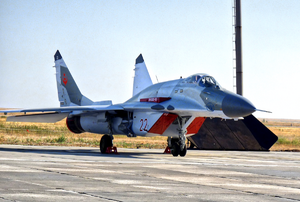
Hordestan maintains modern and powerful armed forces. Most of the material is procured from neighboring countries. Some military models, such as the KIK-29 fighter, are manufactured under license in own factories. Few of the equipment is slightly outdated. Fragile high-tech is usually avoided for cost reasons. The high acquisition and maintenance costs bear no relation to the high demands on the material in the steppes and deserts.
Hordestan's armed forces currently have a strength of around 450,000 soldiers (0.8% of the population). There are also around 260,000 reservists and 80,000 people who serve in paramilitary organizations.
The Ground Forces have the largest share, followed by the Air Force. The relatively small green-water navy is only responsible for protecting the port city of Öskem and Öskem Bay. Compulsory military service has been in force since 1955, and for women since 1965.
Hordestan invests 2.8% of its economic output in the military. The Supreme Commander of the Armed Forces is the Chairperson of the Union Council, together with the General Staff and the Minister of Defence.
According to unconfirmed reports, Hordestan has all the facilities for enriching weapons-grade uranium. There is also a test center for short- and medium-range missiles in the centrally located town of Kosmopol. Whether Hordestan already has nuclear weapons or plans to do so is unknown. However, the government denies this.


